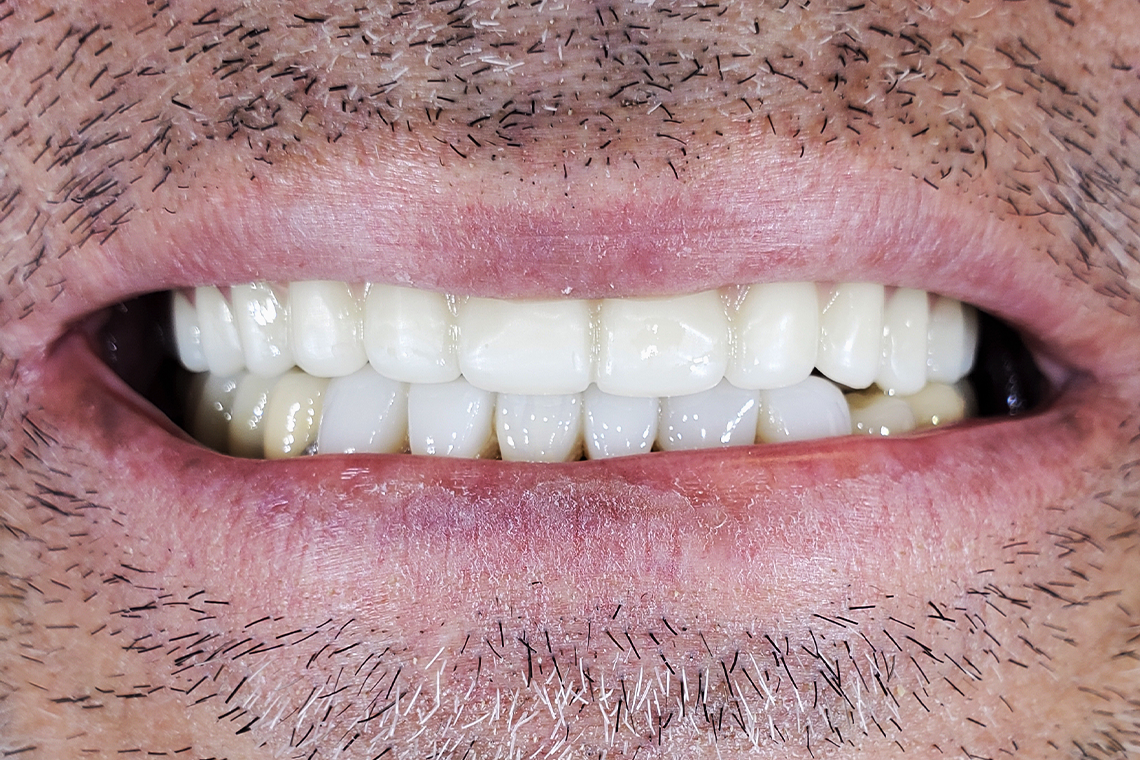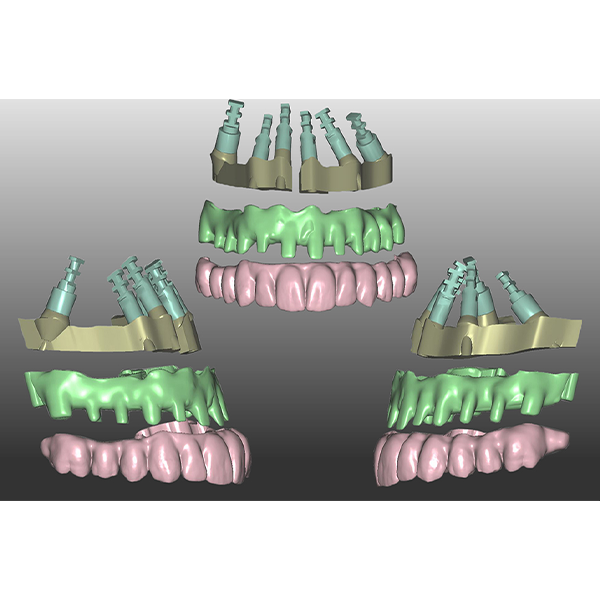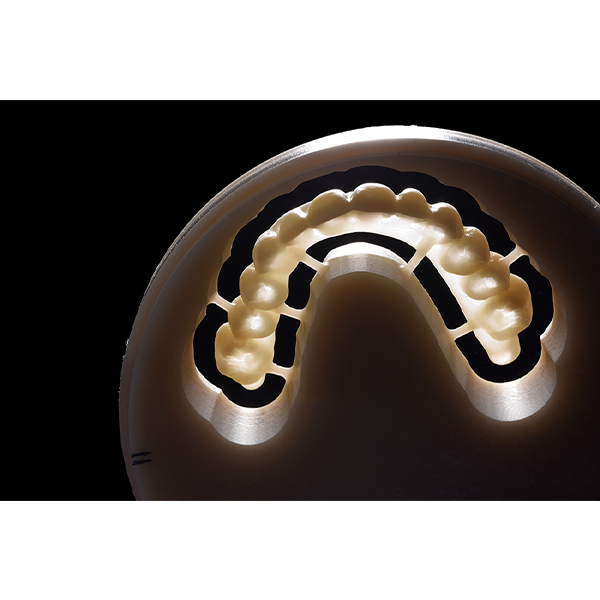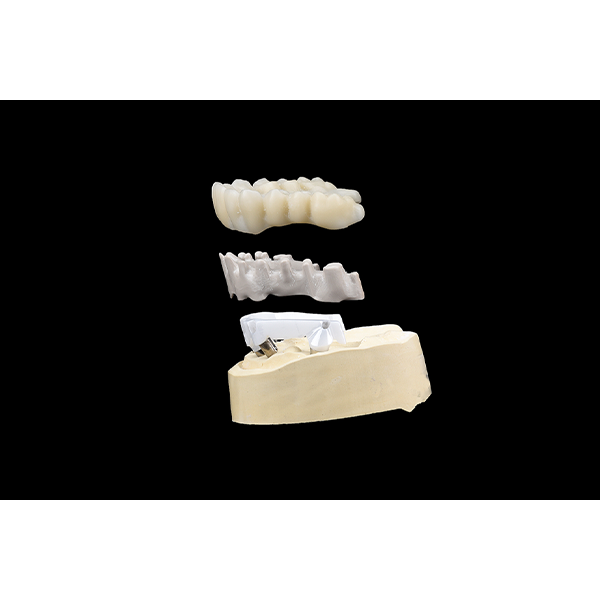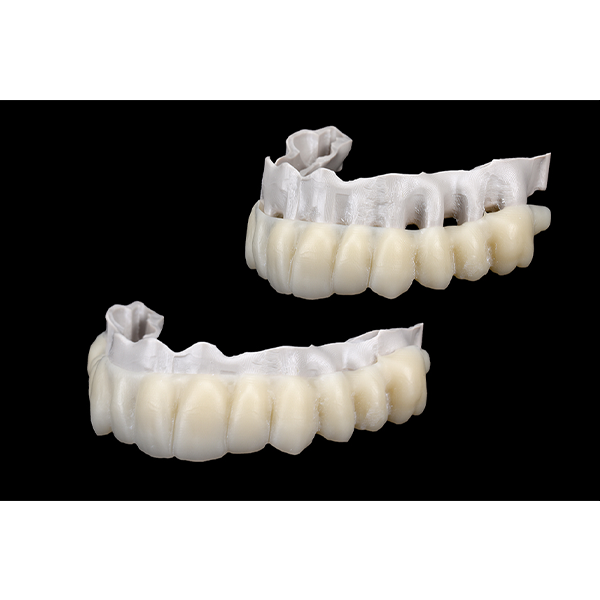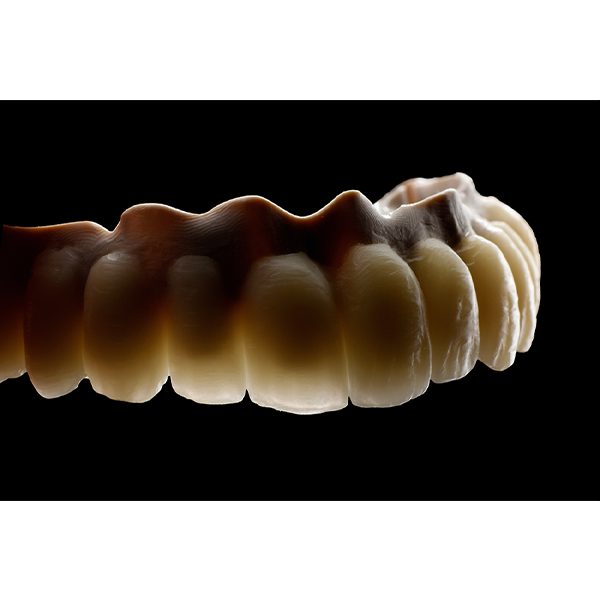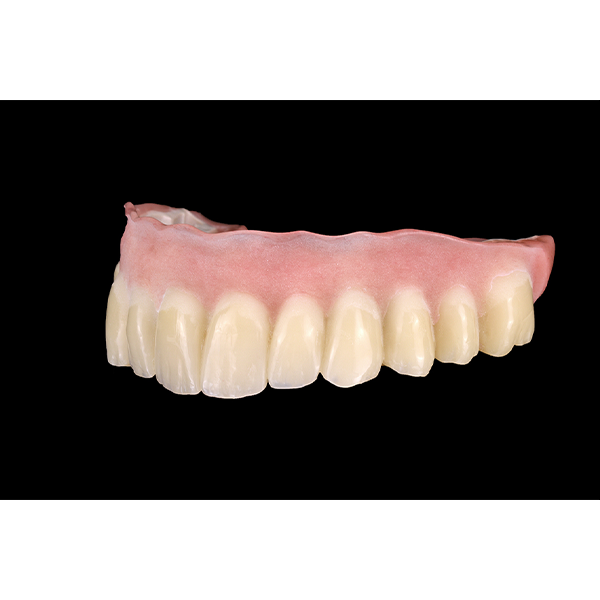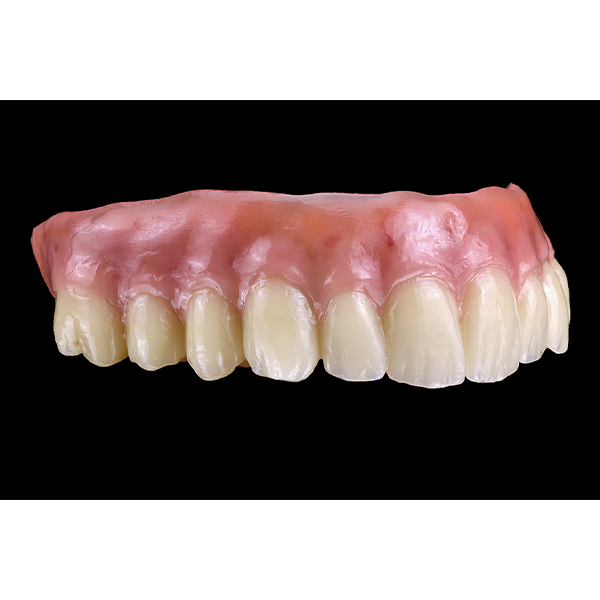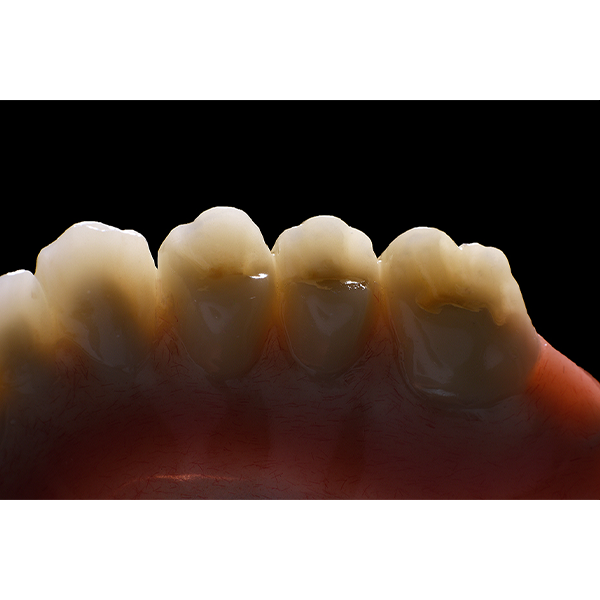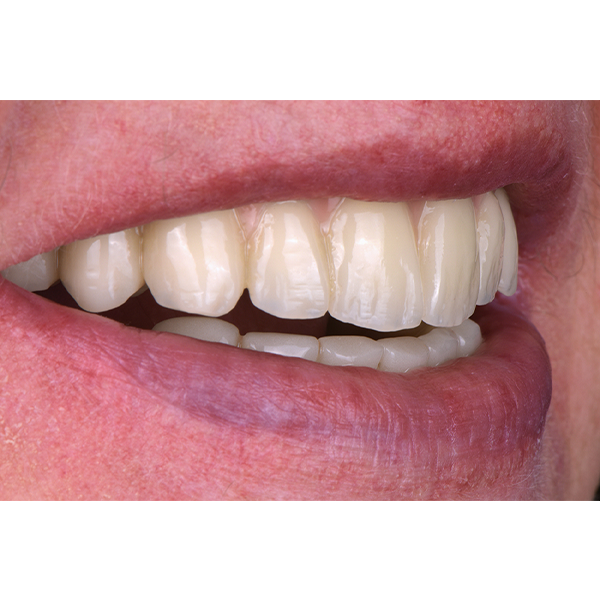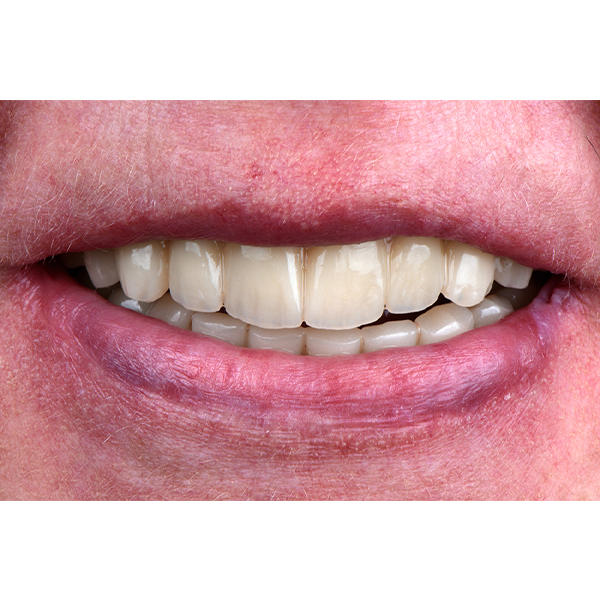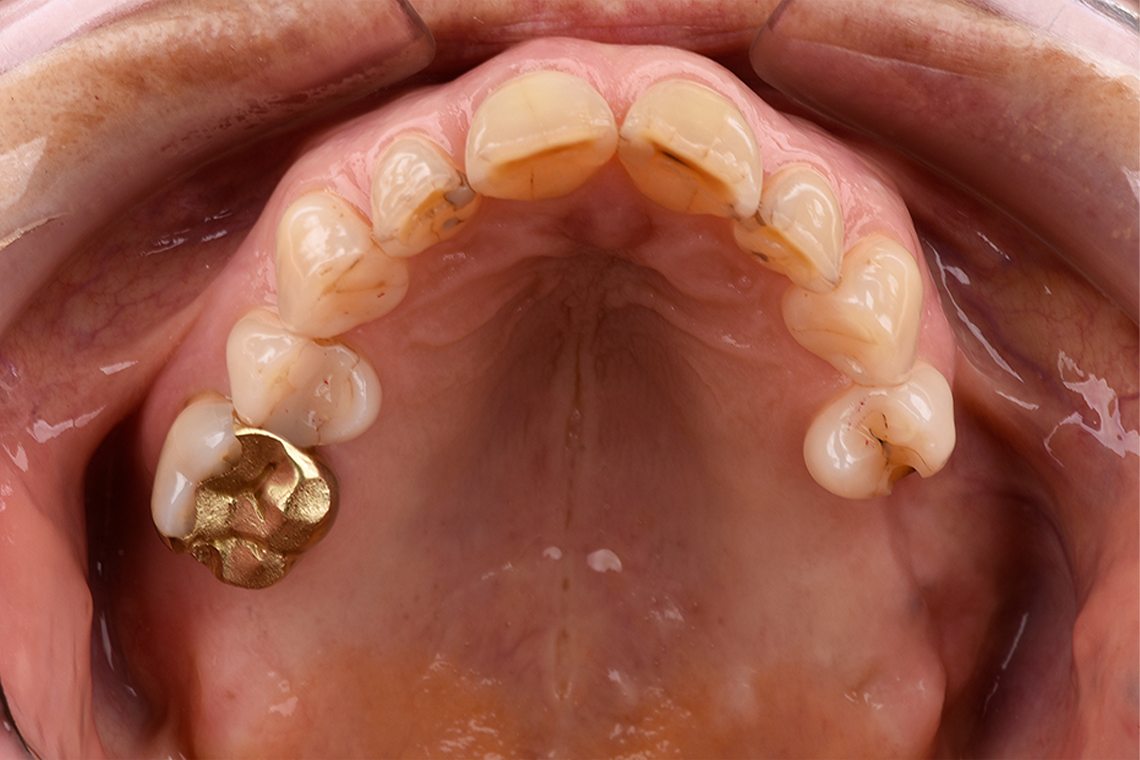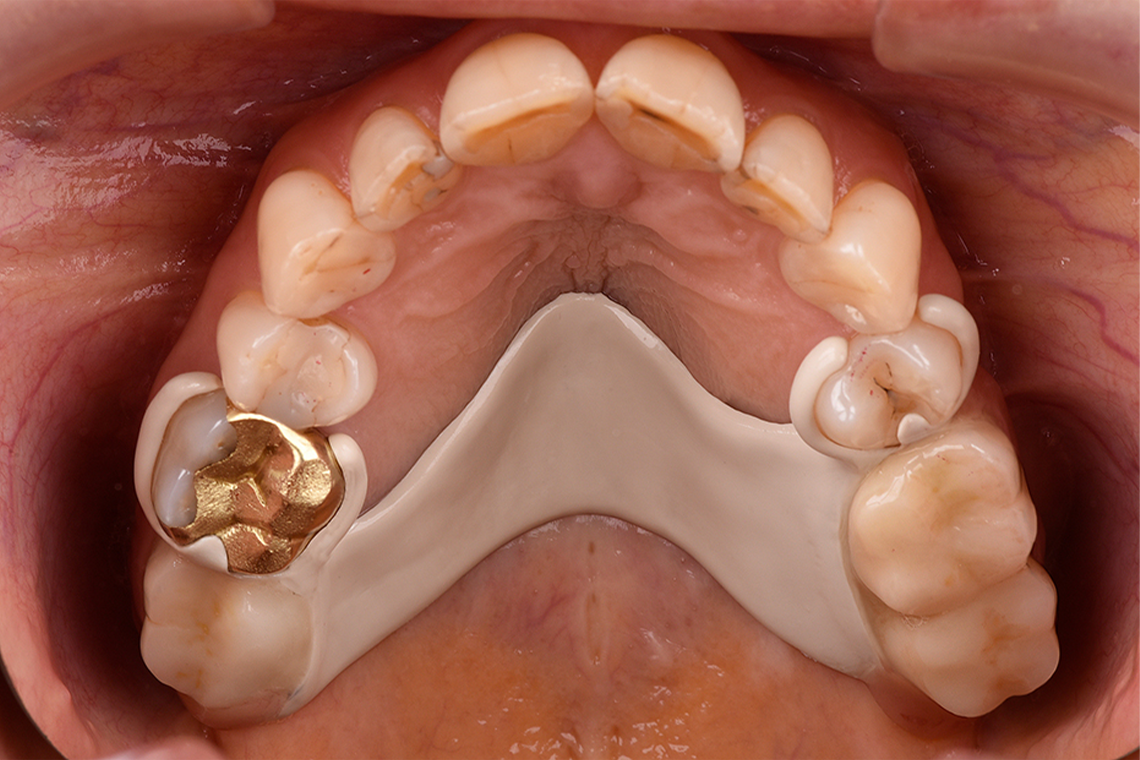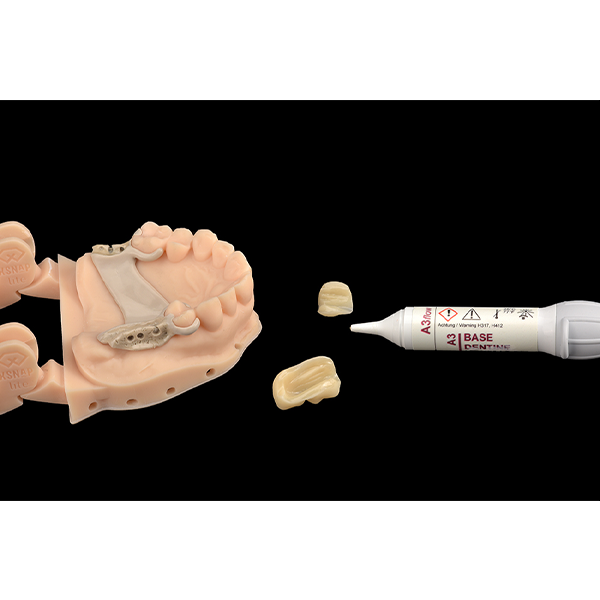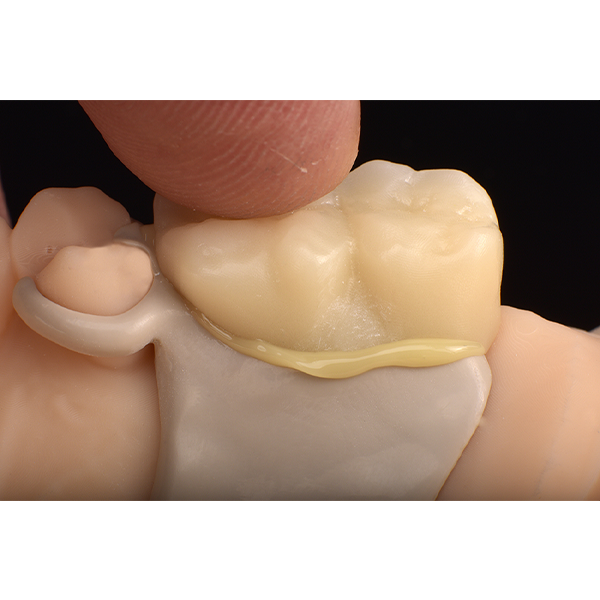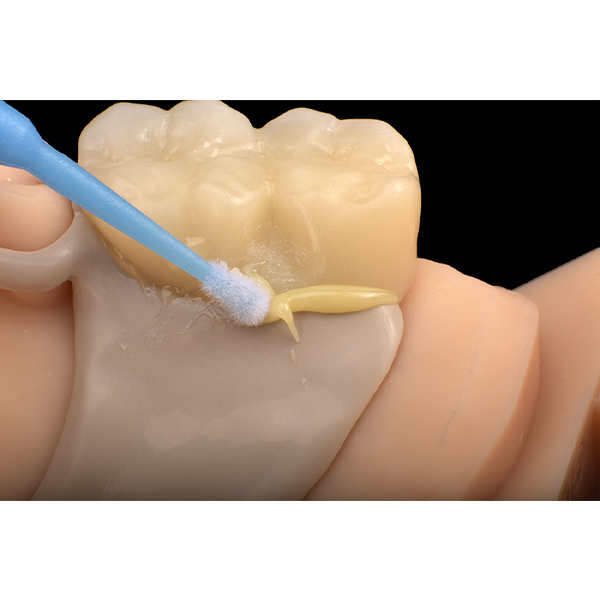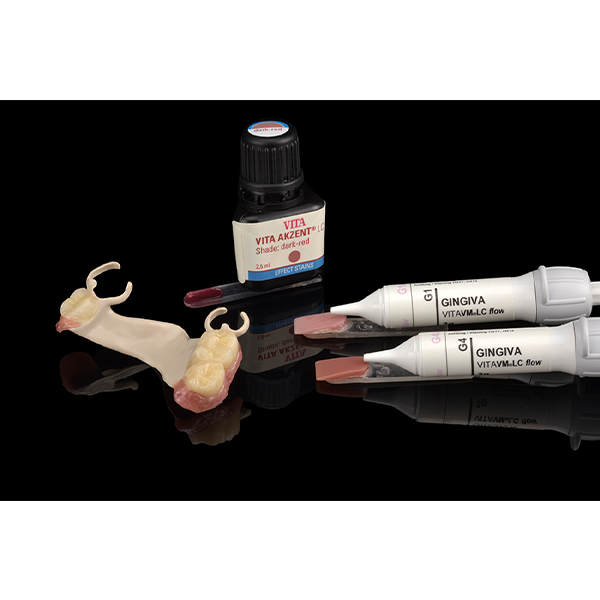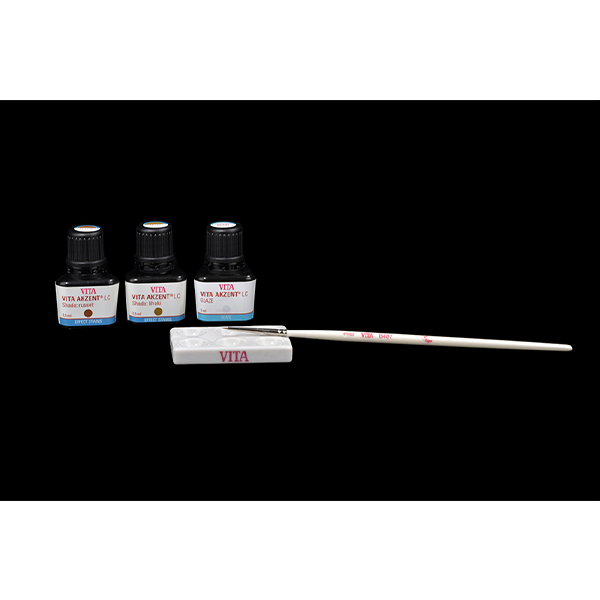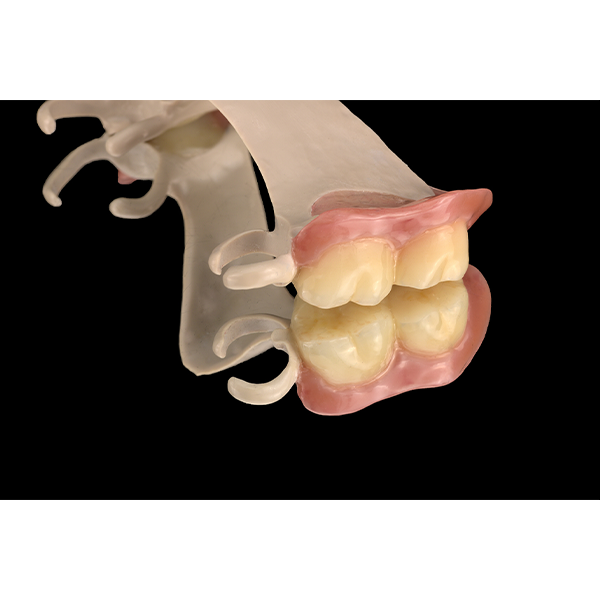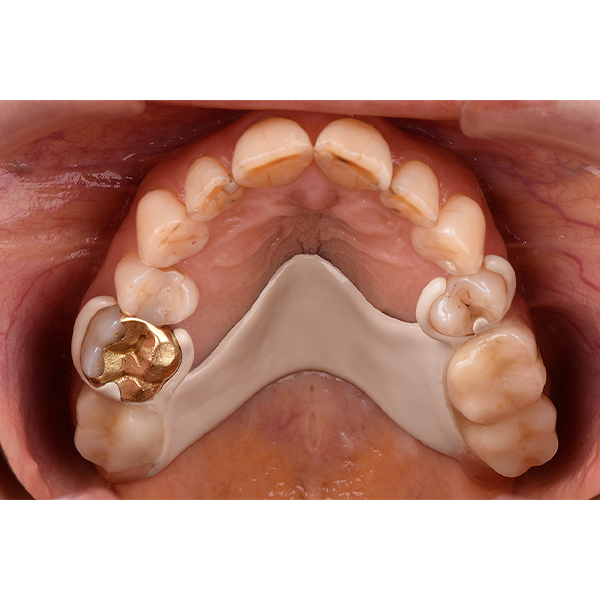On this page, fellow professionals will inspire you with intriguing case reports documenting the variety of application scenarios possible using VITA VIONIC DENT DISC multiColor.
The range of indications for the VITA VIONIC DENT DISC multiColor exceeds the classic full denture by far. It is also possible to fabricate removable restorations on mini implants. What's more, the classic clasp denture can also be fabricated quickly and easily.
Happy Reading.
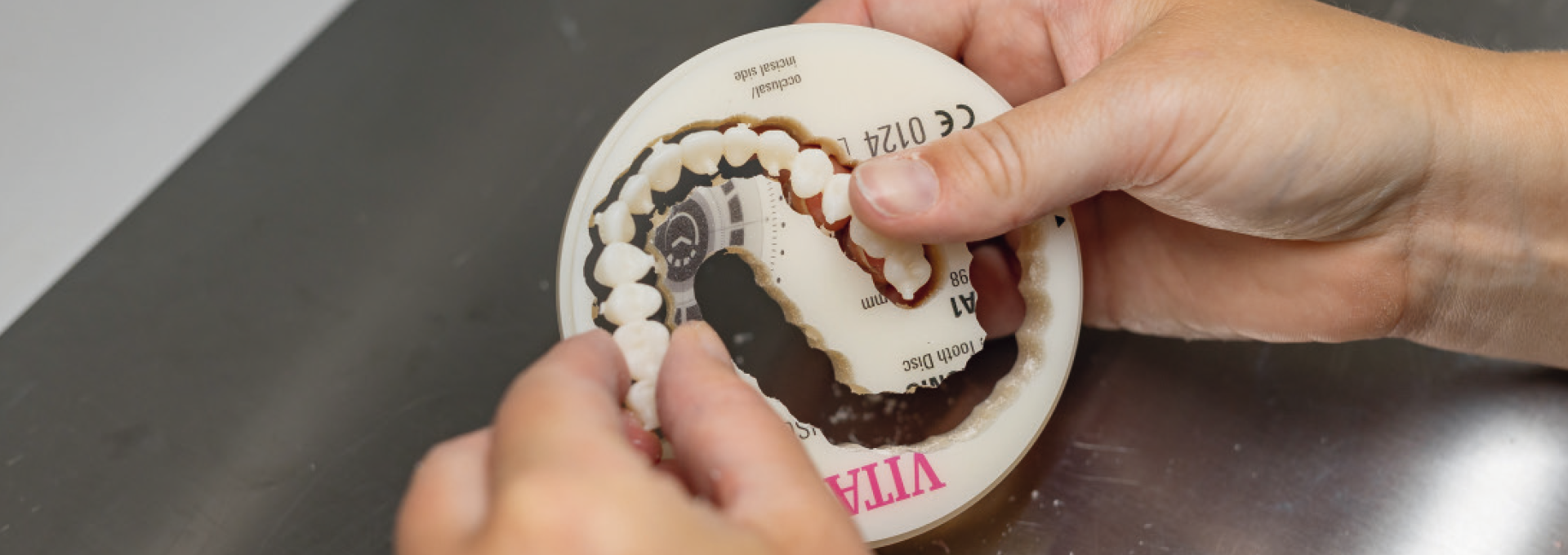
The milled tooth for long-lasting full and partial dentures
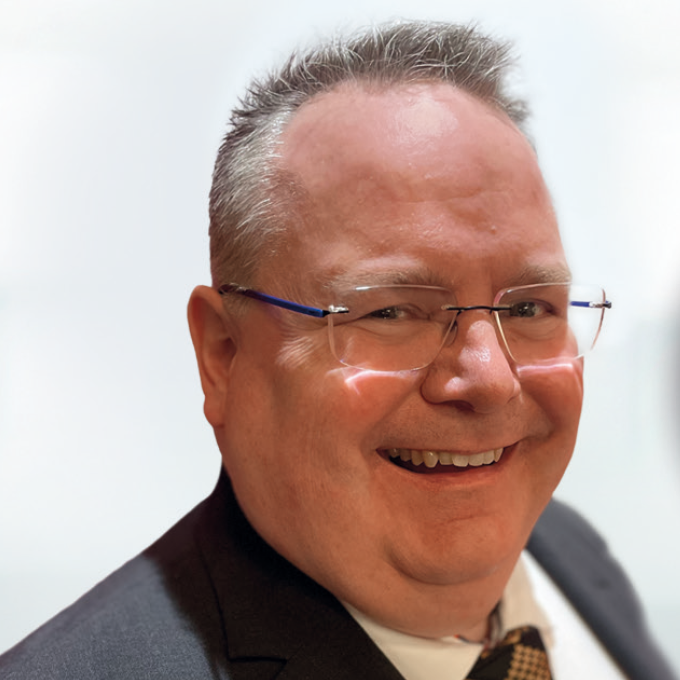
Occlusal freedom with VITA VIONIC DENT DISC multiColor.
In this case report, Marc Wagenseil shows how traditional experience and new technology work together successfully in complex implant cases.
I had the opportunity to challenge myself, as well as the digital technology. An implant-supported full class 1 denture in the upper jaw was to be manufactured using the most recent 3shape software (3shape A/S, Copenhagen, Denmark) and polychromatic composite disk VITA VIONIC DENT DISC multiColor (VITA Zahnfabrik, Bad Säckingen, Germany), which has recently arrived on the market, for the subtractive manufacturing of denture teeth. The interaction of traditional experience with new technology inspired me to once again break new ground, and to challenge the status quo and my own professional complacency when treating complex implant cases.
Case study
The patient came to the practice because he needed a new restoration in the edentulous upper jaw. Since the patient did not like the fit, the foreign body sensation or the functionality of a conventional denture, implant insertion had been suggested in advance, to which the patient consented. The new full denture was to be stabilized on top of four implants with Novaloc abutments (Straumann, Freiburg, Germany). In the treatment plan, we decided to manufacture the full denture using the digital workflow. The goal was to show whether the digital denture could be manufactured more easily, and whether a similar or even better fit could be achieved after integration, compared with conventional full dentures. Of particular interest here was the integration itself, as well as whether the abutments had to be integrated into the denture base in the treatment chair or in the laboratory.
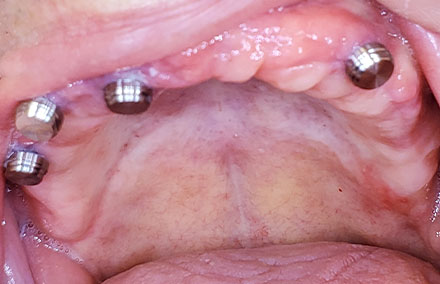
The upper jaw after the insertion of the four implants.
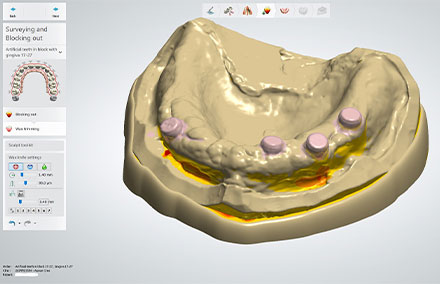
The virtual model during the analysis and block out phase.
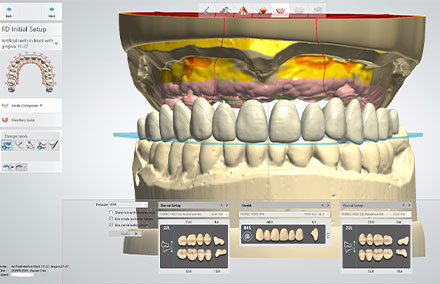
The virtual setup with the selection of tooth shapes.
The treatment phase included the following steps:
1. The palate portion was to be freely designed.
2. The base from the VITA VIONIC BASE DISC HI should not be additionally reinforced.
3. The angulation of the implants should not be corrected. This decision was made because of the flexible angulation compensation with the different Novaloc Locators. They make it possible to compensate for the leverage provided by the extended free end. At the same time, the the strain on the implants was reduced despite the unfavorable positioning while chewing. A prosthetic correction of the angulation would only increase and strengthen the leverage effect. A trouble-free, occlusal freedom in centric was also essential in order to provide even more compensation for the load stress.
4. The focus was on making the occlusal morphology of the teeth functional within the patient‘s chewing cycles, while at the same time transferring the freedom of movement concept to the VITAPAN LINGOFORM posterior teeth. The VITA VIONIC DIGITAL VIGO denture tooth library, available in the 3shape software, is based on the design of the VITA VIONIC VIGO prefabricated teeth, which are in turn based on the design of the VITAPAN EXCELL anterior teeth and the VITAPAN LINGOFORM posterior teeth. Their basic functional principle was automatically transferred to the patient‘s occlusion. Note: The VITA VIONIC DENT DISC multiColor is made from the same VITA MRP (Microfiller Reinforced Polymermatrix) composite formulation as the premium teeth VITAPAN EXCELL and VITAPAN LINGOFORM.
5. Treatment continued with intraoral scans of the lower dental arch and the alveolar ridge in the upper jaw. Note: The updated version of 3shape software (3Shape Dental System 2022) includes an option for the prosthetic implant components used in this treatment. Once the scans and registration were uploaded, the design of the denture began. VITA VIONIC VIGO O45 and 22L were the teeth selected. The posterior contacts were adjusted and confirmed in order to implement freedom in centric.
6. The dental arch and denture base were manufactured subtractively and fixed using VITA VIONIC BOND.
7. Due to the virtual integration of the Novaloc Locators in the software and the high milling precision, the matrices clicked into the denture base after subtractive manufacturing. To ensure a secure bond, the matrices were also integrated into the denture base using DTK adhesive (Bredent, Senden, Bavaria).
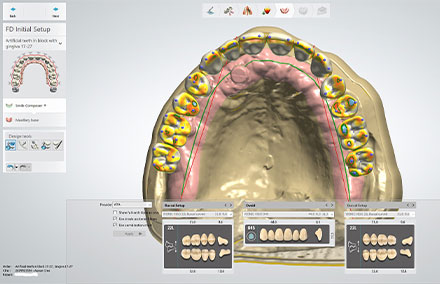
Checking the occlusal contacts and the freedom in centric.
Background information
Freedom in centric: Freedom in centric is defined as a “flat area” in the central fossa in which the antagonist cusps have 0.5 to 1 mm of eccentric freedom of movement upon contact, unaffected by tooth inclination. All natural teeth work according to this concept, but very few denture teeth have it integrated. Why is freedom in centric important? This concept is important because denture teeth are not innervated. This means that a patient cannot feel when the teeth are in occlusion or if they are almost in occlusion. It is important to note that there is food between the teeth during chewing and it is not possible to create perfect centric contact with each individual chewing cycle, as is possible in the articulator during the manufacture of dentures. And then there is also the fact that full dentures are supported by mucous membranes. When considering these two aspects, it is actually inconceivable that a patient with full dentures can always return precisely to centricity. For the same reason, the natural dentition – even if we can feel our teeth during the chewing process - cannot achieve precise centricity after each chewing cycle. This is also the main cause of instability and tension within the denture. Why was freedom in centric important for the success of this treatment? Due to the distribution of the implant abutments, a free occlusal concept without interference was important for preventing a leverage effect. A prefabricated tooth with a locked centric would not allow this compensation to achieve a good denture fit and the desired function. This applies in the present case, especially with regard to the pronounced free end distal from the area of the implant support. For this reason, the patient needs a flexible and adjustable occlusal design.
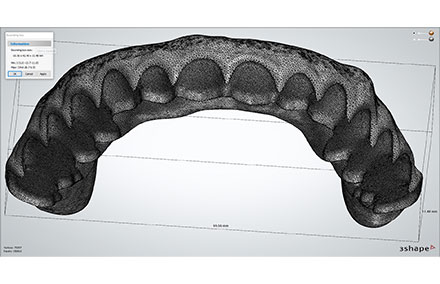
The STL file of the dental arch for the denture.
Matrize
As already described, special attention was paid to the locators because the matrices were integrated into the denture base in the laboratory and not at the patient‘s chair. As a result, we had to check whether the dimensional transfer of the implant position into the software, in conjunction with the precise subtractive manufacturing, would make it unnecessary to integrate the matrices on the patient chairside. Bonding in the laboratory can reduce chair time by 1.5 to 2 hours. That is much more comfortable for the patient because less work needs to be performed inside the mouth. However, the matrices can also be fixed in the laboratory with an accurate model and a careful, precise conventional procedure. Subtractive manufacturing of the base and bonding of the matrices in the laboratory was effective and accurate in this case. Due to the complex implant distribution, a precise relationship between implant head and matrix was a must, especially in this clinical situation.
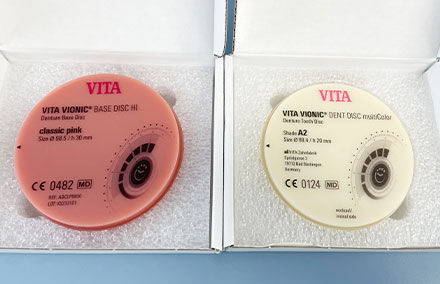
VITA VIONIC BASE DISC HI and VITA VIONIC DENT DISC multiColor.
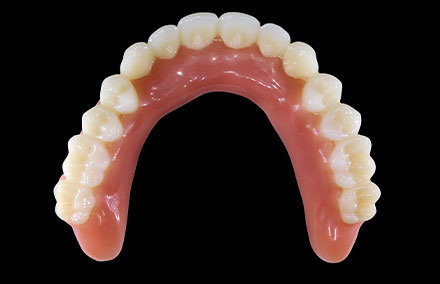
The completed digital denture.
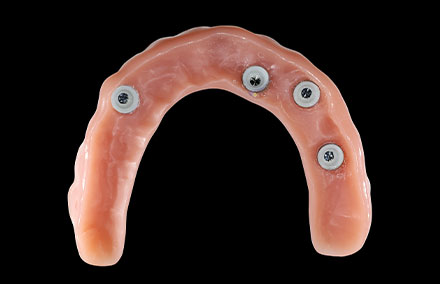
Basal view of the denture with the integrated matrices.
Summary
- Analog or digitally manufactured denture teeth that are designed with occlusal freedom provide stability, flexibility and adaptability to the patient‘s chewing cycle. The occlusal design can be modified in the production of tooth material with the VITA VIONIC DENT DISC multiColor to obtain the desired reliability and function.
- Hitting and sliding on the main cusps is the main cause of these well-known denture problems.
- This treatment plan demonstrates the challenges of dealing with one‘s own professional complacency, and the digital workflow for the production of implant-supported dentures.
- The VITA VIONIC DENT DISC multiColor enabled an easyto- implement and time-saving workflow that created a high-quality denture.
Summary
As denture professionals, we have to create this form of care specifically for each patient and not expect them to simply adapt to their new dentures. In order to achieve this, denture teeth that are adaptable must be used. On the other hand, self-reflection is important to prevent complacency and to allow an adaptation of the skills needed for the specific requirements of the patient case. Freedom in centric is the possibility of moving within the centric contact and therefore not to be blocked in a bite. This concept allows for flexible occlusal adjustment to the patient‘s needs, but has only been integrated into a few prosthetic tooth designs available to us. In this case, the successful treatment can be attributed to precisely this freedom, which is contained in the VITA tooth library and in the subtractively manufactured dental arch from the VITA VIONIC DENT DISC multiColor. If we want to be superheroes for our patients, we need to think outside the box when it comes to complete dentures. Digital workflow manufacturing is another viable “tool in your arsenal” to provide your patients with consistent, highquality removable dentures. It matters what type of teeth you use for traditional or digital manufacturing. Find out about the freedom in centric of the VITAPAN LINGOFORM posterior tooth set and the VITA VIONIC DIGITAL VIGO denture tooth library with the VITA VIONIC DENT DISC multiColor. Freedom is great!
The author is grateful to his patients, VITA Zahnfabrik, Aurum Lab Calgary and, especially, Jason Atwood.
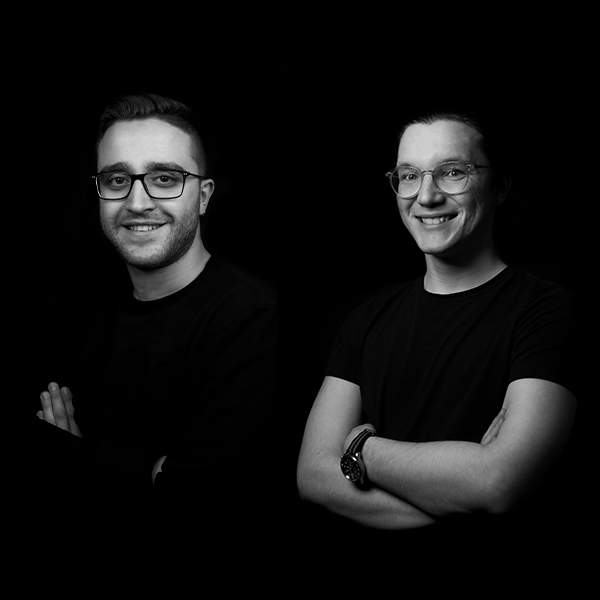
VITA teeth made from multichromatic composite discs VIONIC DENT DISC multiColor
The multichromatic disc made of the proven VITA MRP (microfiller reinforced polymer matrix) composite formulation now offers the well-known quality and esthetics of VITA premium teeth for combination prosthetics, which are created using the design software to perfectly fit the patient. In the following interview, Lukas Wichnalek and Arbnor Saraci (both of Zahntechnik Wichnalek – HIGHFIELD DESIGN, Augsburg, Germany) report on their successful use of the disc.
When fabricating combination prosthetics, it was common practice to make basal and occlusal modifications to prefabricated teeth. Every tooth had to be handled individually and adapted to the framework structure. The next logical step was to fabricate the dental material on frameworks individually using a single CAD/CAM-supported mould. The VITA VIONIC DENT DISC multiColor comes from a company whose knowledge of prefabricated teeth has grown historically for 100 years and is part of the company's DNA and name: VITA Zahnfabrik. The multichromatic disc made of the proven VITA MRP (microfiller reinforced polymer matrix) composite formulation now offers the well-known quality and esthetics of VITA premium teeth for combination prosthetics, which are created using the design software to perfectly fit the patient. In the following interview, Lukas Wichnalek and Arbnor Saraci (both of Zahntechnik Wichnalek – HIGHFIELD DESIGN, Augsburg, Germany) report on their successful use of the disc.
What made you choose VITA VIONIC DENT DISC multiColor for the CAD/CAM-supported fabrication of combination prosthetics? What kind of work do you use the material for?
Lukas Wichnalek: VITA premium teeth have been proven clinically and in the laboratory. We use the VITAPAN EXCELL, the VITAPAN LINGOFORM and the VITA PHYSIODENS ourselves. When we learned that there was going to be a multichromatic disc made of the same composite material that would offer the same workability - abrasion resistance and esthetics for the digital workflow - we were immediately intrigued.
Arbnor Saraci: The VITA VIONIC DENT DISC multiColor allows us to create the tooth material individually and accurately in the CAD software using a single cast in the proven quality of the prefabricated teeth. We use the composite material for implant and partial prosthetics. The need to tediously grind out individual teeth to adapt them to framework structures is now a thing of the past in our laboratory.
What would some other alternatives for fabricating the tooth elements be, and what advantages does the VITA VIONIC DENT DISC multiColor offer in this context?
Lukas Wichnalek: Prefabricated teeth can still be milled and adjusted. Composite layering on the secondary framework is also an option, but it is extremely time-consuming and requires experience. The injection technique with flowable composite is also possible, although the production of a prototype takes quite a long time to prepare in advance, which means that no shade gradient can be created.
Arbnor Saraci: In contrast, the shade gradient is already integrated into the VITA VIONIC DENT DISC multiColor, and I obtain a tooth material that is absolutely free of air bubbles after the CAD/CAM-supported fabrication. In terms of abrasion resistance and overall longevity, dental arches that are milled out in one piece are certainly more durable than manually layered or injected composite.
What is your process for preparing the VITA VIONIC DENT DISC multiColor? How did the finishing process go?
Lukas Wichnalek: The dental material comes out of the milling unit with high precision. As a result, the micromorphology that we select from our tooth database is already beautifully achieved. After removing the workpiece from the VITA VIONIC DENT DISC multiColor, I can immediately concentrate on the fine details, i.e., the micromorphology, texture and polish.
Arbnor Saraci: The composite material of the VITA VIONIC DENT DISC multiColor is really easy to process and polish. We first use cross-cut milling cutters, and then fine diamond-coated grinding instruments. This is followed by a simple pre-polishing using the VITA ENAMIC Polishing Set Technical, and a short high-gloss polishing using VITA Polish Hybrid (which is matched to the material), as well as a brush with goat hair bristles and a leather buff.
What feedback have you received from practitioners regarding the esthetics of the VITA VIONIC DENT DISC multiColor?
Lukas Wichnalek: Of course, the shade matches the VITA shade standards, so you automatically buy the right shade with the blank. This is a huge advantage, especially when it comes to partial dentures. The shade accuracy with the VITA VM LC flow veneering composite is also a great advantage, in terms of quickly creating a basic shade harmony between telescopes and the tooth material from the VITA VIONIC DENT DISC multiColor.
Arbnor Saraci: And the real highlight is that the disc and its integrated shade gradient ensure that the tooth material has a natural appearance. The balanced shade gradient automatically creates a vibrant translucency in the thinner incisal edge. This is why the teeth that are individually fabricated from VITA VIONIC DENT DISC multiColor are so popular with our customers, and above all, the patients.
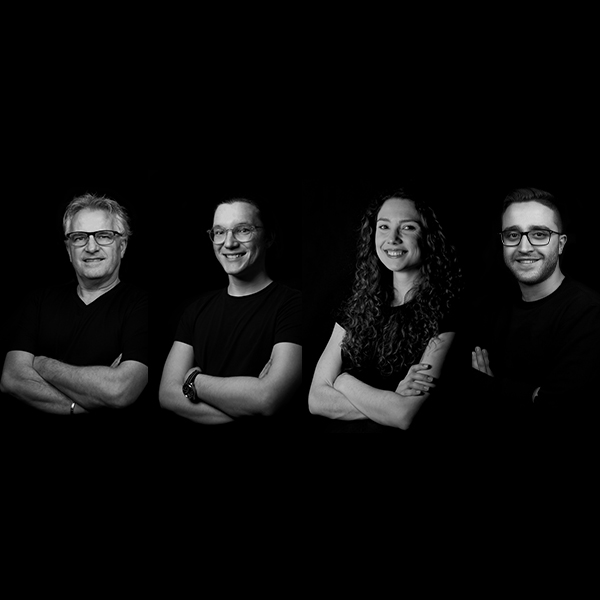
Precision-fit premium teeth from the polychromatic disc.
In the following, Norbert Wichnalek, Lukas Wichnalek, Patricia Strimb and Arbnor Saraci (all Zahntechnik Wichnalek – HIGHFIELD.DESIGN, Augsburg, Germany) show how the polychromatic VITA VIONIC DENT DISC multiColor is now being used to create precision-fit premium teeth in a digital workflow, and discuss the advantages this offers.
Manually adjusting denture teeth to a model casting framework is tedious work that does not allow for true precision. There is a fair amount of guesswork involved as it is ground out until it fits, and often more of the basal tooth is sacrificed than would have been necessary. With the digital workflow, innovative materials for removable partial dentures, which now enable custom-fit prosthetic components based on the lock-and-key principle, have been introduced. These only need to be bonded together using modern adhesive systems. This means that high-precision production technology is replacing the guesswork of manual grinding. In the following, Norbert Wichnalek, Lukas Wichnalek, Patricia Strimb and Arbnor Saraci (all Zahntechnik Wichnalek – HIGHFIELD.DESIGN, Augsburg, Germany) show how the polychromatic VITA VIONIC DENT DISC multiColor is now being used to create precision-fit premium teeth in a digital workflow, and discuss the advantages this offers.
A routine case
A patient in his early 60s presented at a dental practice for a routine visit. Teeth 17, 26 and 27 were missing in his upper jaw. Due to the free-end situation, mastication was limited. The patient also wanted the situation to be stabilized so that he could later be fitted with fixed implants. The dentures needed to be as inconspicuous as possible, be as comfortable as possible and not too expensive. The decision was made to use a clasp denture with a PEEK framework in order to avoid exposing any metal clasps, and to offer the desired level of comfort, thanks to its low weight. The tooth material on the denture saddles was to be milled out of the VITA VIONIC DENT DISC multiColor in shade A3 with a precise fit. As with the proven VITA premium teeth, the polychromatic disc is based on the same VITA MRP composite formulation, ensuring high abrasion resistance and a long service life. The shade gradient integrated into the composite crown provides a basic natural appearance, which is why the material is also ideal for use in the anterior region.
Optimum adhesive gap and individual occlusion
After the intraoral scan of the dental arches and the habitual final bite position, the prosthetic components were designed to fit together precisely in the exocad software (exocad, Darmstadt, Germany). The framework structure was designed using Juvora Dental PEEK natural (Juvora, Lancashire, UK). The precision-fit tooth material from the VITA VIONIC DENT DISC multiColor then followed on the saddles, with the saddle base being incorporated into the design. Teeth 26 and 27 were also given an interlocking design, and the adhesive gap was kept even and as small as possible to ensure the greatest possible stability. If the adhesive gap is too small, the bond will be weaker; if the adhesive gap is too large and inhomogeneous, this can result in chipping. It was possible to functionally design the occlusion to match the natural opposing dentition. Both prosthetic components were then fabricated one after the other in the imes-icore 350i PRO milling unit (imesicore, Eiterfeld, Germany) with CAD/CAM support.
Elaboration and bonding
The tooth material was finished and the micromorphology determined using standard grinding tools. This was followed by a simple pre-polishing using the VITA ENAMIC Polishing Set technical and a short high-gloss polishing using VITA Polish Hybrid (both VITA Zahnfabrik, Bad Säckingen, Germany), as well as a brush with goat hair bristles and a leather buff. The basal adhesive surfaces of the prepared tooth material and the complete saddles made of PEEK were first cleaned and conditioned in a vacuum plasma chamber – normal practice in our laboratory – using oxygen and argon as the ignition gas. Afterwards, conditioning was done with 50 μm aluminum oxide and the universal VITA VM LC Primer. This was followed by controlled adhesive cementation of the denture components using the flowable and light-curing composite VITA VM LC flow BASE DENTINE A3 (all VITA Zahnfabrik, Bad Säckingen, Germany).
Gingival reproduction
The basal, vestibular and oral parts of the saddle were then completed with cold-curing resin. After sandblasting again with 50 μm aluminum oxide and conditioning the base with the VITA VM LC Primer, deeper blood vessels in the area of the mobile gingiva and in the interdental areas were established with the light-curing composite stain VITA AKZENT LC EFFECT STAINS dark-red (VITA Zahnfabrik, Bad Säckingen, Germany). After suitable fixation with the polymerization light, VITA VM LC flow GINGIVA 4 (G4/brown-red) was used to create a thinly tapering mucosa, which also created a fine, definitive gingival margin around the teeth in the vestibular area, which was no longer subtractive as it progressed. After 90 seconds of intermediate curing, cervical and interdental contouring was performed with GINGIVA 1 (G1/dusky pink).
Characterization and finishing
The palatal tooth and base areas from the VITA VIONIC DENT DISC multiColor were not individualized gingivally. To prevent an oxygen inhibition layer, final curing was carried out in 180 seconds using the Otoflash G171 polymerization device (NK Optik, Baierbrunn, Germany) in a wavelength range of 280- 580 nm under an inert gas device with nitrogen. The entire saddle area was then washed off, sandblasted with 50 μm aluminum oxide, and the tooth material in the fissures and interdentally characterized with the composite stains VITA AKZENT LC EFFECT STAINS russet and khaki. Finally, a uniform gloss level was established with a wafer-thin application of VITA AKZENT LC GLAZE. After another 90-second curing period – as described above – the high-gloss polish was applied with a cotton buff using light pressure.
Discussion and conclusion
The VITA VIONIC DENT DISC multiColor now makes it possible to create removable prosthetics with premium teeth from the disc individually, and as required. Only the dental material that is needed is produced with CAD/CAM support. The "guesswork" involved in the tedious and time-consuming process of grinding out prefabricated teeth is a thing of the past. The ability to fabricate interlocking and integrate parts of the base into the tooth material provides maximum durability. The optimized design of the adhesive gap also ensures stability and a reliable bond. The polychromatic VITA VIONIC DENT DISC multiColor offers an inherently natural appearance, meaning that finishing and polishing are usually all it takes to achieve the desired esthetic effect. The basic shade accuracy of the composite shade to the VITA shade standards, in combination with the equally accurate and coordinated material components from VITA Zahnfabrik, provides true added value for fabricating removable partial dentures reliably and efficiently.
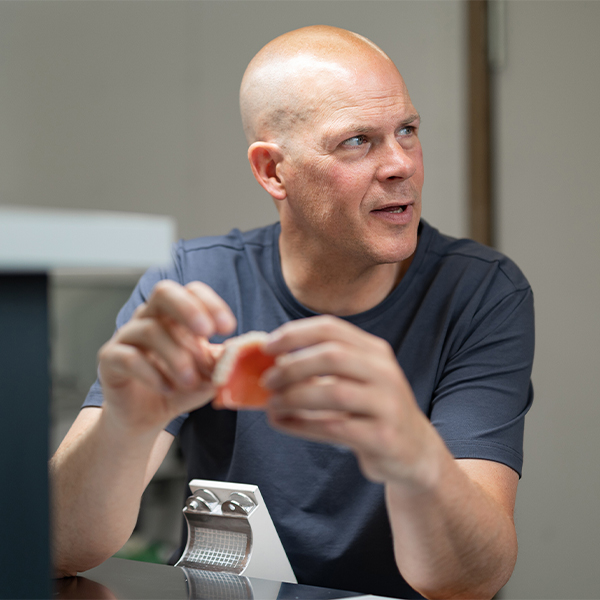
Eelco van Wort - Opportunities of digital full dentures
Dental technician Eelco van Wort has owned the milling center Dental Design Centrum (Haarlem, Netherlands) together with his brother Martijn van Wort for 13 years and is an aspiring denturist.
Compared to crown and bridge work, digital full denture prosthetics is still a very young field, but it has been part of their portfolio for five years. In the following interview, Eelco talks about his experiences and the developments he has observed during this time.
What are the reasons why digital full dentures are becoming more and more established in the Netherlands?
We offer a dental technology service with our milling center. We have noticed that more and more practitioners are able to design their own complete dentures in CAD software, but are not equipped to manufacture them with CAD/CAM support. And that's where we come in. Of course, the lack of specialist staff is also a key reason for the rise in digital full dentures. Automation means that the milling unit can also work independently overnight. There have been great leaps in development in terms of quality, so we have decided that our clients should benefit from this too.
Where do you see decisive differences, perhaps also advantages and disadvantages, between analog and digital fabrication of removable full dentures?
I don't think the time factor is even that decisive. If someone has a lot of total prosthetic experience, they may even be a little faster than the digital workflow if they move quickly. But if they've had a bad weekend, for example, the result on a Monday morning may not be as successful as usual. In the digital workflow, the quality will always be the same. Regardless of the human element, two millimeters will remain two millimeers. The setups are always reproducible. For me, this is the decisive reason as to why I produce complete dentures in the digital workflow.
Who are your customers and how have they accepted digital full dentures? Are there price differences between analog and digital fabrication?
We generally do not make analog prosthetics. We have focused on producing digital full dentures with VITA VIONIC VIGO. We then only have to bond the ready-to-use premium teeth into the base with VITA VIONIC BOND. This enables us to offer better quality than other milling centers that mill the teeth from unfilled PMMA, for example. Our clients are mainly denturists who can't use CAD/CAM. So once I'm a denturist, I'll become my own client (laughs). I then order the complete dentures from my own company.
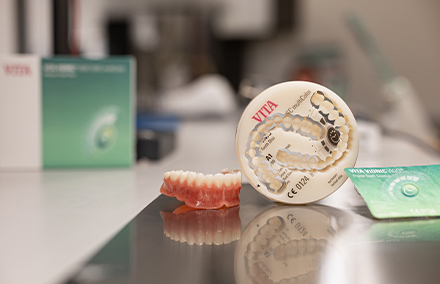
Depending on the case, the prefabricated teeth VITA VIONIC VIGO or the VITA VIONIC DENT DISC multiColor are used.
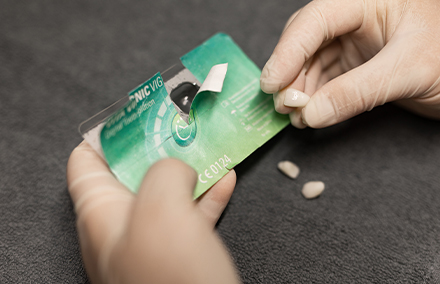
The preconditioned and morphologically optimized VITA VIONIC VIGO is removed and ready for use.
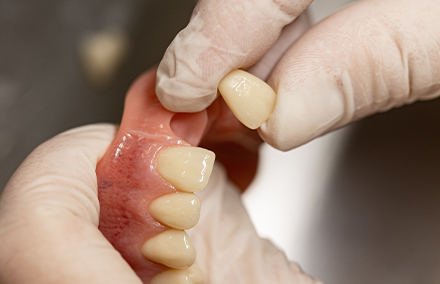
The prefabricated tooth for the digital prosthesis, VITA VIONIC VIGO, during the fit check.
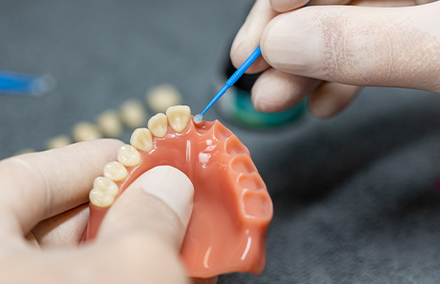
The alveolus of the denture base is wetted with the VITA VIONIC BOND adhesive.
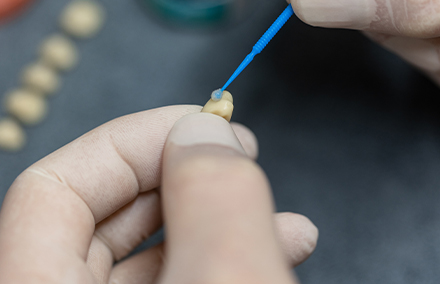
The basal-circular application of VITA VIONIC BOND on the VITA VIONIC VIGO prefabricated tooth.
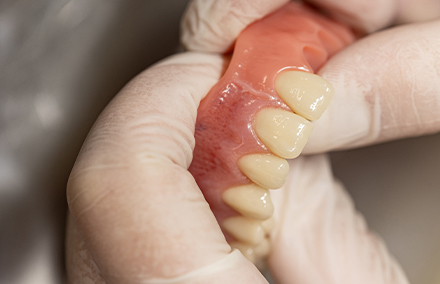
Tooth 21 after its precise insertion into the denture base.
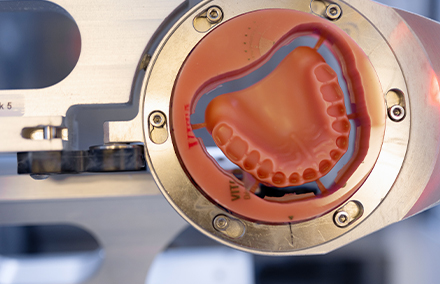
The subtractively fabricated denture base made of VITA VIONIC BASE DISC HI and ...
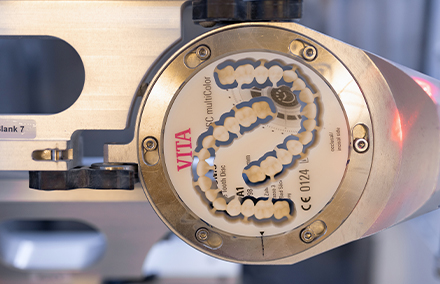
... the matching dental arch from the VITA VIONIC DENT DISC multiColor.
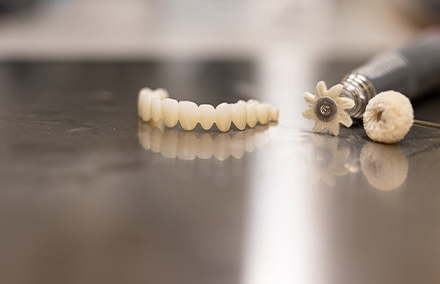
The polychromatic premium composite after finishing and polishing.
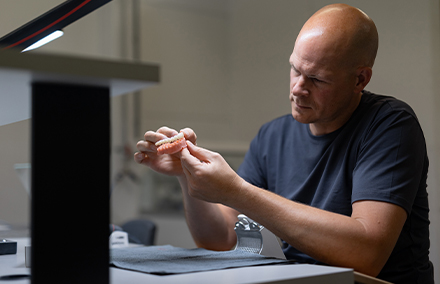
Gear rim and base fit together precisely according to the key-lock principle.
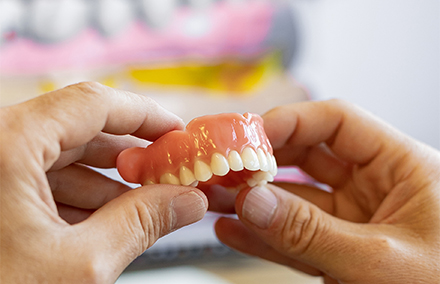
The finished prosthesis made of VITA VIONIC BASE DISC HI and VITA VIONIC DENT DISC multiColor.
Is there a price difference between analog and digital full dentures, and if so, how big is it?
When we started producing CAD/CAM-supported full dentures around six years ago, the material components were still a little too expensive compared to analog production. However, we have observed that the material prices for digital full dentures have become lower and lower over time, making it more and more economically attractive. The classic wax set-up is probably a little cheaper in terms of materials, but the time required is significantly higher in most cases. The bottom line is that digital full dentures are now comparable in price to analog full dentures.
What experience have you had with the VIONIC DENT DISC multiColor so far? For which removable restorations do you mill your teeth yourself?
The VITA VIONIC DENT DISC multiColor has closed a gap in our portfolio. The composite disc is a real advantage, especially when space is limited. With a very low vertical bite height, the material gives us the functional leeway we need. We will also use it for immediate dentures. It offers high-end quality in the subtractive fabrication of dental material, as the composite formulation is the same as with all other VITA premium teeth. It can therefore be assumed that the quality is better than that of conventional, unfilled PMMA blanks. I am very pleased that VITA VIONIC DENT DISC multiColor is available.
How do you assess the development of additive manufacturing in removable full denture prosthetics? Are you planning to work with this technology?
3D printing is certainly the future of full denture prosthetics. Even as a milling center, we cannot close our eyes to it. It is cheaper and will probably also be faster. A single-colored denture base can already be printed easily today. This does not yet apply to robust teeth with a color gradient and translucency in the right places. Sustainability is now also a major issue in dentistry and dental technology. Only the material that is really needed is used as an additive. This is much better for the environment than milling from a blank and throwing away the leftovers.
In your opinion, how will the technology and the job profile of dental technicians and denturists change in the future?
I think digitalization will become mainstream in the future. Materials will continue to improve and processes will become faster and more consistent. Digitalization will definitely prevail in the technical fabrication of dental restorations. VITA VIONIC VIGO and the VITA VIONIC DENT DISC multiColor are already helping us to produce functional and esthetic complete dentures in a digital workflow to give patients their teeth back and make them happy. As a dentist, however, you should always bear in mind that the option for analog treatment of patients will continue fort he forseeable future.
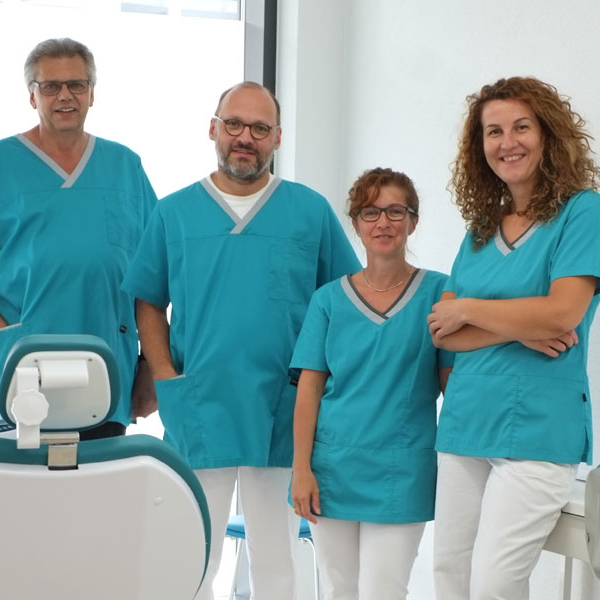
U. Christen - Two Different Perspectives: CAD/CAM-Supported Manufacturing for Full Dentures
CAD/CAM has long been established in fixed prosthetics. More and more, the digital workflow is also finding its place in total prosthetic rehabilitation. The fundamental question for denturists and dental technicians is which manufacturing method is the right one for their business model.
In the following, denturist Urban Christen (Hunzenschwil, Switzerland), with his practice for dental prosthetics, provides answers together with dental technician and upcoming denturist Eelco van Wort with his Milling Center Dental Design Centrum (Haarlem, Netherlands) from different perspectives as to which workflow might be the right one.
Since when did you start offering your customers digital, removable dentures? What was the decisive factor in including CAD/CAM fabricated removable dentures in your portfolio?
Urban Christen: To be honest, I have already worked with CAD/CAM-supported fabricated complete dentures since they were approved for patient care. That was 15 years ago now. The higher precision than with analog fabrication excited me from the very beginning, especially with regard to occlusion. The bite simply fits without distortion, and occlusal adjustments are no longer necessary. And the workflow is repeatable one-to-one.
Eelco van Wort: CAD/CAM-supported fabrication of complete dentures has been part of our milling center portfolio for about five years. Since VITA VIONIC can be used in open CAD/CAM systems, we are offering digital dentures to our customers. In the Netherlands, digital dentures have increased considerably due to a lack of technical personnel. On the material side, everything is now available to produce total prosthetics digitally in the desired quality.
Where do you see differences – advantages and disadvantages – between subtractive and additive production of removable dentures?
Urban Christen: Both methods are very, very precise. At the moment, the material quality is still slightly better with subtractive manufacturing. Soon, however, additive materials will come onto the market where there will no longer be any differences in quality. A milling unit is much more expensive to buy than a printer and is already completely occupied with a blank. The printer can be used for several bases at the same time, maintenance is inexpensive, and there is no instrument wear.
Eelco van Wort: I think 3D printing will be the future. As a milling center, we can’t close our eyes to that either. It is already cheaper and probably faster. The process is more sustainable because there is much less waste. In the future, this will be the manufacturing method for total prosthetics. The single-coloured denture bases are already easy to print. Teeth with shade and translucency gradient cannot yet be manufactured additively in the desired quality.
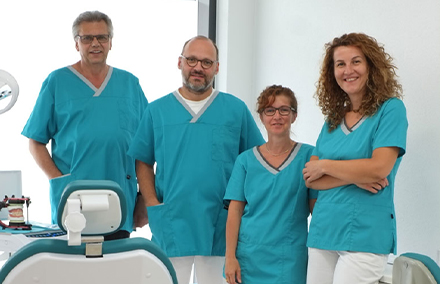
Urban Christen (second from left) with his practice team.
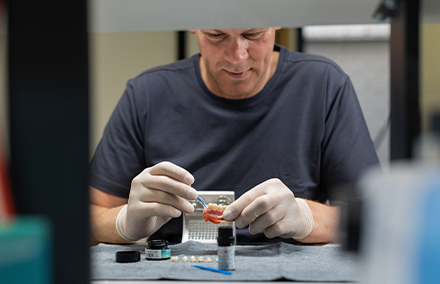
Eelco van Wort is bonding the preconditioned VITA VIONIC VIGO teeth to the denture base.
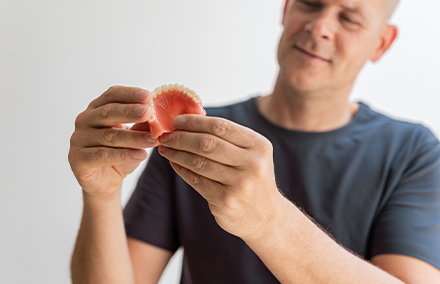
Final digital denture made of VITA VIONIC BASE DISC and VITA VIONIC VIGO teeth.
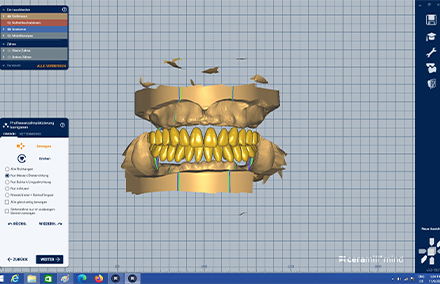
A virtual set-up of Urban Christen with VITA VIONIC VIGO in the exocad software.
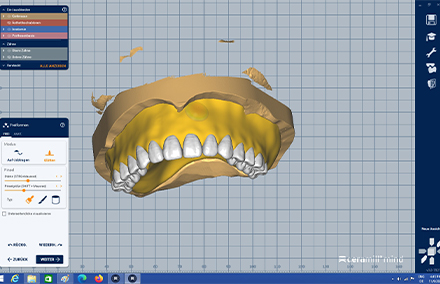
Urban Christen’s modelling of the denture base in the CAD software.
How quickly can the technology pay for itself in terms of removable prosthetics? What pays off faster, subtractive or additive manufacturing?
Urban Christen: Of course, a direct comparison depends on which milling unit is purchased. Generally speaking, it can be said that amortization takes longer when it is used solely for complete dentures. If crowns and bridges are also produced on the same machine, the payback is much faster. The printer pays for itself more quickly in comparison. It is also important to note that additive manufacturing is certainly more favourable in terms of running costs.
Eelco van Wort: I don’t really have a comparison. At the moment, we only work subtractively. As a milling center, we naturally use our milling units in such a way that they are always working to capacity. Then, such a machine can pay for itself more quickly. Purchasing an additional printer makes no sense in the current situation. In general, additive manufacturing is certainly more cost-effective, so we will also start printing at some point for sure.
Which CAD/CAM workflow did you choose in the end, and why is this, at the moment, the appropriate solution for you?
Urban Christen: To tell you the truth, I have just decided on both production methods (laughs). At the moment, I am using a subtractive approach for the denture base with the VITA VIONIC BASE DISC. For teeth, I use the preconditioned VITA VIONIC VIGO, which is simple and fast bonded into the alveoli of the denture base without any modifications. For immediate dentures, I use the VITA VIONIC VIGO with a printed base.
Eelco van Wort: We also use VITA VIONIC VIGO for teeth because you really only need to bond the precisely fitting teeth to the denture base without using a cold-curing PMMA. In cases of limited space, we will grind out the tooth material from VITA VIONIC DENT DISC multiColour in the future. Of course, as a classical milling center we actually manufacture the denture base only from the blank VITA VIONIC BASE DISC.

